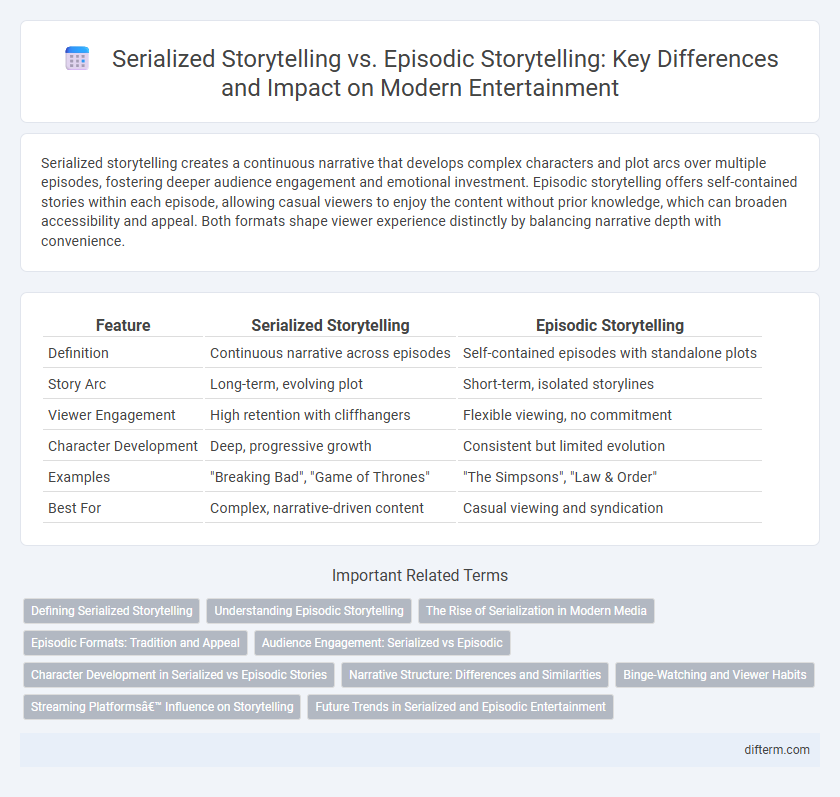Serialized storytelling creates a continuous narrative that develops complex characters and plot arcs over multiple episodes, fostering deeper audience engagement and emotional investment. Episodic storytelling offers self-contained stories within each episode, allowing casual viewers to enjoy the content without prior knowledge, which can broaden accessibility and appeal. Both formats shape viewer experience distinctly by balancing narrative depth with convenience.
Table of Comparison
| Feature | Serialized Storytelling | Episodic Storytelling |
|---|---|---|
| Definition | Continuous narrative across episodes | Self-contained episodes with standalone plots |
| Story Arc | Long-term, evolving plot | Short-term, isolated storylines |
| Viewer Engagement | High retention with cliffhangers | Flexible viewing, no commitment |
| Character Development | Deep, progressive growth | Consistent but limited evolution |
| Examples | "Breaking Bad", "Game of Thrones" | "The Simpsons", "Law & Order" |
| Best For | Complex, narrative-driven content | Casual viewing and syndication |
Defining Serialized Storytelling
Serialized storytelling is a narrative format where a continuous plot unfolds across multiple episodes or installments, demanding viewers to follow each segment sequentially for full comprehension. This approach enhances character development and complex story arcs, commonly seen in television dramas like "Breaking Bad" and streaming series such as "Stranger Things." Serialized storytelling fosters deeper audience engagement by building suspense and emotional investment over time, differentiating it from episodic storytelling where stories are self-contained per episode.
Understanding Episodic Storytelling
Episodic storytelling focuses on self-contained episodes where each installment presents a complete narrative arc, allowing viewers to engage without prior knowledge of previous episodes. This format enhances accessibility and flexibility, making it ideal for casual viewers and syndication. Well-known examples include classic sitcoms like "Friends" and procedural dramas like "Law & Order," which emphasize standalone stories while maintaining character continuity.
The Rise of Serialization in Modern Media
Serialized storytelling in modern media has surged due to platforms like Netflix and HBO prioritizing binge-worthy content that encourages continuous viewer engagement. This approach enhances narrative complexity, allowing character development and plotlines to unfold over multiple episodes or seasons. Streaming services utilize data-driven insights to optimize release schedules, maximizing audience retention and subscription rates.
Episodic Formats: Tradition and Appeal
Episodic storytelling thrives on self-contained episodes where each installment delivers a complete narrative arc, allowing viewers to join at any point without confusion. This format preserves tradition by emphasizing consistent character development and familiar settings, making it ideal for genres like sitcoms and procedural dramas. Its appeal lies in accessibility and flexibility, catering to audiences with limited time and fluctuating viewing habits.
Audience Engagement: Serialized vs Episodic
Serialized storytelling fosters intense audience engagement by creating continuous narrative arcs that encourage viewers to follow the story over multiple episodes, boosting emotional investment and anticipation. Episodic storytelling allows casual viewing and immediate satisfaction through self-contained plots, which attracts audiences seeking flexibility without long-term commitment. The choice between serialized and episodic formats directly impacts viewer retention rates and binge-watching behaviors, with serialized content driving higher loyalty and episodic content appealing to a broader, more varied audience.
Character Development in Serialized vs Episodic Stories
Serialized storytelling allows for deep character development by unfolding complex arcs and evolving personalities over multiple episodes or seasons, creating greater emotional investment. Episodic storytelling often features static characters with limited growth, focusing more on self-contained plots that reset character dynamics each episode. This structure offers accessibility but restricts the nuanced transformation seen in serialized narratives.
Narrative Structure: Differences and Similarities
Serialized storytelling features a continuous narrative arc where each episode builds on the previous one, creating complex character development and ongoing plotlines that demand viewer commitment. Episodic storytelling presents self-contained episodes with distinct beginnings and resolutions, allowing viewers to jump in at any point without needing prior context. Both formats utilize character consistency and thematic elements, but serialized narratives emphasize long-term storytelling while episodic formats prioritize accessibility and standalone entertainment.
Binge-Watching and Viewer Habits
Serialized storytelling, characterized by continuous plotlines across episodes, significantly fuels binge-watching tendencies by creating compelling cliffhangers that drive viewers to watch multiple episodes in one sitting. Episodic storytelling offers self-contained narratives each episode, appealing to casual viewers and facilitating flexible viewing habits without narrative commitment. Streaming platforms leverage serialized content to increase viewer retention, while episodic formats support discovery and accessibility, shaping diverse audience engagement patterns.
Streaming Platforms’ Influence on Storytelling
Streaming platforms have transformed storytelling by popularizing serialized narratives that encourage binge-watching and deeper character development, contrasting with traditional episodic formats that deliver self-contained stories per episode. Algorithms on platforms like Netflix and Amazon Prime promote serialized content to maximize viewer engagement and retention, influencing creators to craft complex, interwoven plotlines. This shift has elevated audience expectations for narrative continuity and intricate story arcs, reshaping the entertainment landscape toward immersive storytelling experiences.
Future Trends in Serialized and Episodic Entertainment
Serialized storytelling is evolving with the rise of binge-watching and interactive platforms, driving deeper audience engagement through complex narratives and character development. Episodic storytelling leverages technological advances like AI-driven content personalization to maintain viewer interest across standalone stories while enabling flexible viewing habits. Future trends indicate a hybrid model emerging, blending serialized depth with episodic accessibility to optimize user retention and satisfaction in streaming services.
Serialized storytelling vs Episodic storytelling Infographic

 difterm.com
difterm.com